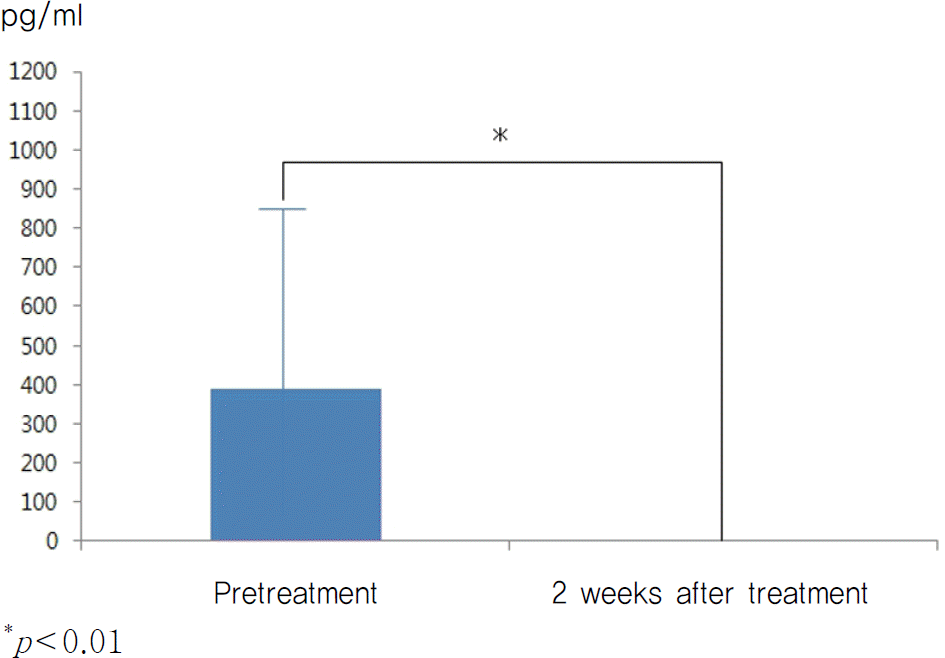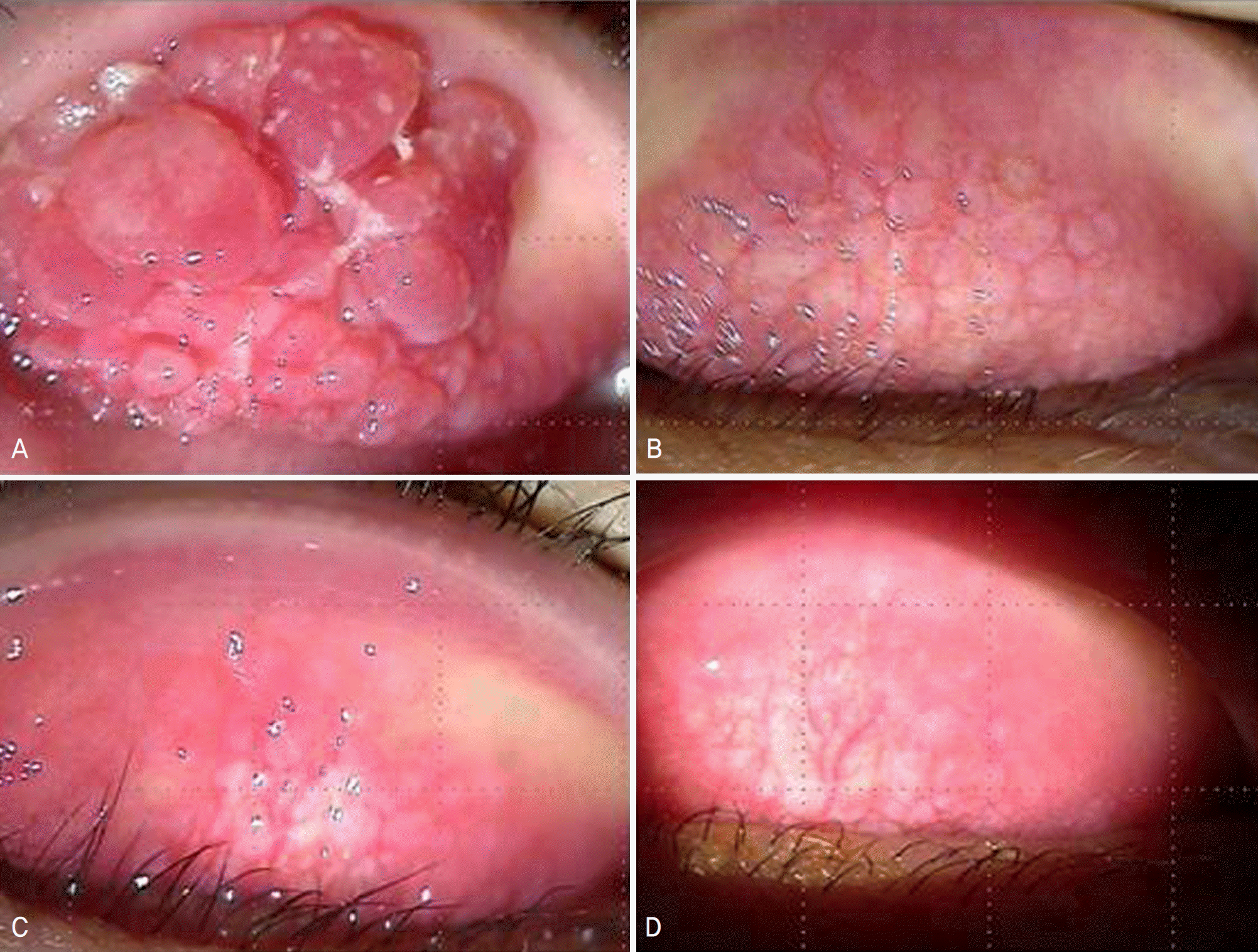Abstract
Purpose
To evaluate the therapeutic effect of the combined treatment of excision of the papillae and a supratarsal injection of triamcinolone on refractory vernal keratoconjunctivitis (VKC).
Methods
Twenty-three eyes of 14 patients with refractory vernal keratoconjunctivitis were included. Patients were treated with the combined excision of papillae and supratarsal injection of triamcinolone. Best corrected visual acuity (BCVA), intraocular pressure, symptoms of itching, tearing, discomfort, secretion and epiphora, and signs including limbal hypertrophy, hyperemia, papilla size, keratitis, corneal neovascularization and blepharitis were evaluated before and two weeks, four weeks, and eight weeks after treatment. The CCL11 level in the tears of each eye were analyzed before and two weeks after treatment.
Results
The mean scores of subjective symptoms and objective signs as well as BCVA were significantly improved two weeks after treatment. CCL11 levels in the tears were 389.5±474.9 pg/ml before treatment and were undetectable two weeks after treatment. Improvement of symptom and sign parameters was maintained up to eight weeks after treatment. However, seven eyes (30.4%) recurred within two weeks after treatment.
References
1. Leonardi A, Smith L, Secchi A. Allergic diseases of the eye. Philadelphia: WB Saunders;2000. p. 179–96.
2. Montan PG, Ekstrom K, Hedlin G, et al. Vernal abdominal in a Stockholm ophthalmic centre-epidemiological, functional, and immunologic investigations. Acta Ophthalmol Scand. 1999; 77:559–63.
4. Bonini S, Bonini S, Lambiase A, et al. Vernal keratoconjunctivitis revisited: a case series of 195 patients with long-term follow up. Ophthalmology. 2000; 107:1157–63.
5. Beigelman MN. Vernal Conjunctivitis. Los Angeles: University of Southern California Press;1950. p. 120–55.
6. Donshik PC, Ehlers WH. The Cornea. 3rd ed.Boston: Brown & Company;1994. p. 295–304.
7. Brody JM, Foster CS. Ocular Infection and Immunity. St Louis: Mosby;1996. p. 35–60.
9. Holsclaw DS, Whitcher JP, Wong IG, Margolis TP. Supratarsal injection of corticosteroid in the treatment of refractory vernal keratoconjunctivitis. Am J Ophthalmol. 1996; 121:243–9.

10. Singh S, Pal V, Dhull CS. Supratarsal injection of corticosteroids in the treatment of refractory vernal keratoconjunctivitis. Indian J Ophthalmol. 2001; 49:241–5.
11. Tanaka M, Takano Y, Dogru M, et al. A comparative evaluation of the efficacy of intraoperative mitomycin C use after the abdominal of cobblestone-like papillae in severe atopic and vernal keratoconjunctivitis. Cornea. 2004; 23:326–9.
12. Nishiwaki-Dantas MC, Dantas PE, Pezzutti S, Finzi S. Surgical abdominal of giant papillae and autologous conjunctival graft in abdominals with severe vernal keratoconjunctivitis and giant papillae. Ophthal Plast Reconstr Surg. 2000; 16:438–42.
13. Ozcan AA, Ersoz TR, Dulger E. Management of severe allergic conjunctivitis with topical cyclosporin a 0.05% eyedrops. Cornea. 2007; 26:1035–8.

14. Stahn C, Löwenberg M, Hommes DW, Buttgereit F. Molecular mechanisms of glucocorticoid action and selective glucocorticoid receptor agonists. Mol Cell Endocrinol. 2007; 15:71–8.

15. Leung DY, Hanifin JM, Charlesworth EN, et al. Disease abdominal of atopic dermatitis: a practice parameter. Ann. Allergy Asthma Immunol. 1997; 79:197–211.
16. Kato N, Fukagawa K, Dogru M, et al. Mechanisms of giant abdominal formation in vernal keratoconjunctivitis. Cornea. 2006; 25:47–52.
17. Miyazaki D, Nakamura T, Ohbayashi M, et al. Ablation of type I hypersensitivity in experimental allergic conjunctivitis by eotax-in-1/CCR3 blockade. Int Immunol. 2009; 21:187–201.

18. Shoji J, Inada N, Sawa M. Antibody array-generated cytokine abdominals of tears of patients with vernal keratoconjunctivitis or giant papillary conjunctivitis. Jpn J Ophthalmol. 2006; 50:195–204.
Figure 1.
Comparison of tear CCL11/Eotaxin level between before and 2 weeks after combined treatment.

Figure 2.
Photographs of the right superior tarsal conjunctiva in a 11-year-old boy with severe vernal keratoconjunctivitis. (A-D) Compared with baseline (A), tarsal papillae significantly improved at 2 weeks (B), 4 weeks (C), and 8 weeks (D) after resection of papillae and supratarsal injection of triamcinolone.

Table 1.
Grading of symptoms and signs in vernal keratoconjunctivitis patients15
Table 2.
Changes of subjective symptoms and signs after combined treatment with papillae excision and supratarsal triamcinolone injection in patients with refractory vernal keratoconjunctivitis
| Baseline | Posttreatment 2 weeks Pos | sttreatment 4 weeks | Posttreatment 8 weeks | |
|---|---|---|---|---|
| Itching | 2.26±0.45 | 0.71±0.46* | 0.54±0.66* | 0.89±0.33* |
| Tearing | 1.96±0.48 | 0.52±0.60* | 0.31±0.63* | 0.56±0.73* |
| Discharge | 2.14±0.47 | 0.50±0.51* | 0.54±0.78* | 0.50±0.54* |
| Discomfort | 2.26±0.62 | 0.67±0.48* | 0.62±0.65* | 0.56±0.73* |
| Photophobia | 1.78±0.74 | 0.43±0.71* | 0.23±0.60* | 0.22±0.44* |
| Limbar hypertrophy | 1.39±0.72 | 0.81±0.51* | 0.69±0.63* | 0.89±0.60* |
| Papillary reaction | 2.91±0.42 | 0.95±0.69* | 1.15±0.69* | 1.15±0.99* |
| Conjunctival hyperemia | 1.74±0.81 | 0.29±0.46* | 0.23±0.44* | 0.56±0.73* |
| Keratitis | 2.52±0.79 | 0.62±0.81* | 0.62±0.96* | 0.78±0.83* |
| Neovascularization | 0.87±0.69 | 0.48±0.81* | 0.08±0.28* | 0.11±0.33* |




 PDF
PDF ePub
ePub Citation
Citation Print
Print


 XML Download
XML Download